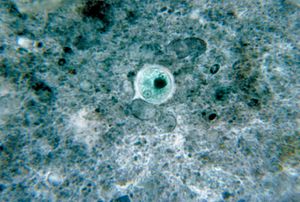Microbial cyst facts for kids

A microbial cyst is like a tiny, tough "sleeping bag" that some very small living things, called microorganisms (or microbes), make for themselves. These microbes can be bacteria or protists. Sometimes, even tiny invertebrate animals make them.
This "sleeping bag" helps the microbe survive when things get tough. It's like they go into a state of suspended animation. Their body processes slow down a lot. They stop eating, moving, and growing.
Making a cyst is called encystment. It also helps microbes travel easily. They can move from one place to another, or from one living thing (a host) to another.
When the microbe finds a good place to live and grow, the cyst wall breaks open. This process is called excystation. The microbe can then become active again.
Why Microbes Form Cysts
Microbes form cysts when their environment becomes difficult. Imagine if it's too hot, too cold, or too dry. They might also form cysts if there isn't enough food or oxygen. Sometimes, harmful chemicals in the environment can also make them form a cyst. These conditions are not good for the microbe to live or grow normally.
What Cysts Are Made Of
The walls of these protective cysts are made from different materials, depending on the microbe.
- The cysts of bacteria are made from their normal cell wall, but it gets much thicker. It adds extra layers of a material called peptidoglycan.
- The cysts of protozoa (a type of protist) have walls made of chitin. This is a special type of glycoprotein.
- Cysts made by nematodes (tiny worms) also use chitin, but they make it even stronger with something called collagen.
Images for kids
See also
 In Spanish: Quiste (biología) para niños
In Spanish: Quiste (biología) para niños



